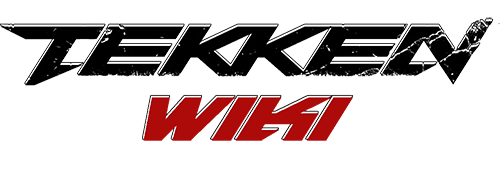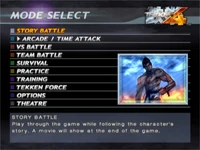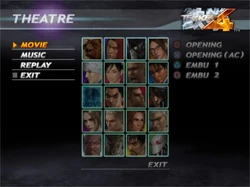No edit summary |
m (→Videos) |
||
| Line 175: | Line 175: | ||
== Videos == |
== Videos == |
||
| + | <gallery widths="200" position="center" spacing="small" captionalign="center"> |
||
| − | <gallery> |
||
File:Tekken 4 Intro HD|Introduction. |
File:Tekken 4 Intro HD|Introduction. |
||
File:Tekken 4 Gameplay with Jin Kazama|A sample of gameplay with Jin Kazama. |
File:Tekken 4 Gameplay with Jin Kazama|A sample of gameplay with Jin Kazama. |
||
Revision as of 15:07, 20 September 2019

|

|
| Developer: Namco |
| Publisher: Namco |
| Producers: Masahiro Kimoto, Katsuhiro Harada & Yuichi Yonemori |
| Platform: Arcade, PlayStation 2 |
| Release date: Arcade
Playstation 2 |
| Genre: Fighting |
| Mode: Single-player, Multiplayer |
| Arcade System: Namco System 246 |
Tekken 4 (鉄拳4 Tekken Fō?, lit. Iron Fist 4) is the fourth main installment in the Tekken video game franchise, and was the second game in the Tekken series released for the PlayStation 2. Developed and published by Namco, it was released as an arcade game in 2001 and on the PlayStation 2 in 2002. While relatively popular in its day, it is often considered by fans to be the worst main-series Tekken game, due to the omission of many popular characters and the introduction of major balance issues and bugs that impaired competitive play. It is also considered the most experimental Tekken game, featuring several game-changing new mechanics that never returned in later iterations.
Gameplay
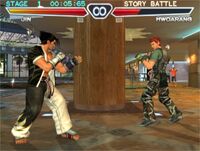
Jin Kazama versus Hwoarang.
Tekken 4 introduced significant new gameplay changes from the previous games in the series. For the first time, it allowed players to maneuver around an arena interacting with walls and other obstacles for extra damage. These "environmental hazards" in turn allowed players to juggle opponents for consecutive combos and allowed the designers to implement a "switch maneuver", which let players escape from cornering and throw the tide in their favor. Also, the game engine had been tweaked to be more focused on the environment, causing the characters to move
more slowly and fluidly than in Tekken Tag Tournament. Finally, the game introduced a brand new graphics system, that featured increased lighting, dynamic physics, and smoother surfaces.
In high-level tournament play, it became apparent that the engine changes caused the game to heavily favor quick jabs and punches, upsetting some fans due to the decline in usefulness of more complex moves and strategies. Jin Kazama especially was very over-powered, and if one were to look at the tournament records, he was used by nearly every top player.
Tekken 4 includes a beat em' up mini-game available from the outset called Tekken Force. Similar to the previous minigame found in Tekken 3, it presents the player with an over-the-shoulder perspective as they fight wave upon wave of Heihachi Mishima's Tekken Force soldiers through four stages, eventually facing Heihachi himself. The player can pick up health and power-ups while they fight waves of enemies. In the mini-game, it is discovered that the Tekken Force soldiers possesses different ranks in the organization, evident in different amounts of stamina, strength, and skill.
Story
Two years ago, Heihachi Mishima failed to capture Ogre. Not willing to give up, Heihachi ordered his researchers to collect blood samples, skin tissue, and hoof fragments left behind by Ogre (or known as True Ogre in its true manifestation) in order to conduct genetic experiments. Heihachi’s goal was to create a new life form by splicing Ogre’s genome with his own. However, the research was unsuccessful.
After extensive experimentation, Heihachi’s bioengineers came to the conclusion that an additional gene - the "Devil Gene" - was necessary in order to successfully splice Ogre’s genetic code into another living organism. Heihachi learned that his own genome lacked the Devil Gene, but he knew someone who had it... Jin Kazama.
Jin, who vanquished Ogre in The King of Iron Fist Tournament 3, was shot and mortally wounded by Heihachi. As his life slipped away, Jin transformed into a Devil. Upon his transformation, he struck down Heihachi and took flight. Jin’s whereabouts were unknown after the Tournament.
Heihachi searched for Jin to no avail. However, Heihachi discovered a photograph during his investigation that stirred his curiosity. The 20-year-old photograph was an image of a burnt corpse covered with laceration wounds. Heihachi paid particular attention to the corpse’s back, which had what looked like deformed, protruding wing-like limbs.
Convinced that the picture was of Kazuya, his own son whom he threw into a volcano 20 years ago, Heihachi diverted all his resources into a search for the body. This search eventually led Heihachi to G Corporation, a cutting-edge biotech firm making unprecedented advances in the field of biogenetics research.
Heihachi discovered that G Corporation found the corpse and extracted and analyzed its genetic data. In fact, Heihachi learned that the company was in the midst of creating a new life form by using the data. Heihachi also determined that Kazuya’s remains and research data were secured at G Corporation’s Nebraska and Nepal research laboratories, respectively.
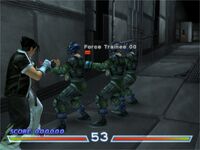
Tekken 4 Tekken Force mode with Jin Kazama.
Friday, 25 December. The Tekken Force raided G Corporation’s maximum security research laboratory in Nepal. The bottom floors of the building were obliterated, and the remaining data storage facility containing file servers was airlifted by a group of heavy-duty helicopters.
At the same time, a separate unit led by Heihachi infiltrated the underground research facility in Nebraska, where Kazuya’s remains were preserved. As Heihachi observed from his helicopter, he soon realized that unlike the Nepal facility, the operations in Nebraska were not going according to plan. The tactical status monitor screens showed the first wave of the Tekken Force troops being blown out from the storage room where Kazuya’s remains were supposedly kept.
A silhouette of a large figure slowly emerged from the room. When Heihachi could see clearly enough, he instantly recognized the large figure as Kazuya.
Kazuya was resurrected in G Corporation’s research facility. After his resurrection, Kazuya offered his body as research material to determine the true nature of the Devil that resided within him. Kazuya’s goal was to unify his two selves into one. Kazuya theorized that if he unified his body with the Devil, he would be able to truly harness its powers. He could then finally take revenge against Heihachi and the Mishima Zaibatsu (Financial Empire).
Enraged that Heihachi thwarted his plans, Kazuya obliterated the heavily armed Tekken Force and vanished into the flames of the lab’s wreckage. Heihachi was infuriated by Kazuya’s escape and took out his anger on his hapless subordinates who reported the escape.
Doctor Abel, Heihachi’s lead scientific advisor, urged the enraged Heihachi to quickly find a way to capture Kazuya. Once his anger subsided, Heihachi focused his mind and decided on a plan. An evil smile crept upon his lips.
Two years had passed since The King of Iron Fist Tournament 3. The Mishima Zaibatsu announced The King of Iron Fist Tournament 4 and placed the massive financial empire as the top prize. The champion who manages to defeat Heihachi at the end of the Tournament would inherit the Mishima Zaibatsu.
Well aware that the tournament is just a trap designed to lure him out, Kazuya nevertheless enters - it is his chance to defeat Heihachi.
After defeating so many opponents, Kazuya arrives at stage 7 to face his son, Jin Kazama, who ever since the ending of the Third Tournament, had a grudge against the Mishima. After training in traditional karate for the last 2 years, Jin was finally ready to destroy the zaibatsu and put an end to the cursed Mishima bloodline. However, he was captured and taken to Hon-Maru, while others reported Kazuya as the default winner. Although sensing Heihachi's interference with Jin's disappearance, he proceeded to the final stage.
When Kazuya met Heihachi, he asked what he did to Jin, with Heihachi saying that he would tell him after the fight. Pulling out all the stops, Kazuya was victorious, "Now take me to him as you promised." A few hours later, Kazuya and Heihachi finally arrived at Hon-Maru. Seeing his son for the first time, Devil suddenly took over. "So, you were with him after all, my half." Hearing those words come out of Kazuya's mouth, Heihachi asked "Who are you?" with Devil replying "I am what you refer to as 'Devil'. 20 years ago I lost a part of myself when you nearly killed me."
He then proceeded to knock Heihachi out of the room, and take Jin's devil out. However, it ended in failure, and Kazuya once again regained control. "I see." he mutters. "I did not know the method of unifying our powers." He then taunted Jin to rise, which Jin did. When Jin finally frees himself, he starts to have final thoughts. "You! If only you were dead. Once I kill you, it'll all be over!" suddenly an enraged Jin fights and nearly kills Kazuya. When Kazuya is defeated, Heihachi once again walks over to his limp body.
"What a pathetic wretch, you worthless coward." He then proceeded to kill Jin and take his Devil Gene for himself. However, Heihachi was also defeated by Jin. As Jin morphed into his Devil form, he prepared to deliver the final blow and kill Heihachi, once and for all. However, a bright light overwhelmed Jin, and as he saw a spiritual guidance of his mother, Jun Kazama, he let Heihachi go. "Thank my mother, Jun Kazama," he told Heihachi, and once again, he flew off into the night, leaving no sign of danger anywhere.
Characters
| Returning characters |
|---|
| Hwoarang |
| Kazuya Mishima |
| King II |
| Ling Xiaoyu |
| Marshall Law |
| Paul Phoenix |
| Yoshimitsu |
| Bryan Fury (unlockable) |
| Eddy Gordo (unlockable, acts as a costume swap of Christie Monteiro) |
| Heihachi Mishima (unlockable, final boss) |
| Lee Chaolan (unlockable) |
| Lei Wulong (unlockable) |
| Jin Kazama (unlockable) |
| Julia Chang (unlockable) |
| Kuma II (unlockable) |
| Nina Williams (unlockable) |
| Panda (unlockable, acts as a costume swap of Kuma) |
| New characters |
|---|
| Christie Monteiro |
| Craig Marduk |
| Steve Fox |
| Combot (unlockable) |
| Miharu Hirano (unlockable, acts as a costume swap of Ling Xiaoyu) |
| Violet (unlockable, Lee Chaolan in disguise, acts as a costume swap of Lee) |
| Cameos |
|---|
| Armor King I (cameo in Marduk's prologue) |
| Devil Kazuya (cameo in Kazuya's ending) |
| Doctor Bosconovitch (cameo in Bryan's ending) |
| Jun Kazama (cameo in Jin's ending) |
Stages
| Stage |
|---|
| Airport |
| Arena |
| Beach |
| Building |
| Hon-Maru (unlockable) |
| Jungle |
| Laboratory |
| Mall |
| Parking Area |
| Shinjuku |
| Statue (unlockable) |
| Underground |
Videos
Trivia
- This Tekken game is notable for having these distinctions:
- It is the first game to feature proper spoken dialogue for all characters, and it is also the only game where subtitles before and after a fight when a character speaks are not displayed, even when speaking in languages other than the in-game language (so Korean and Japanese for English versions).
- The only game in the series where characters can freely move before an actual fight can start. Also the only game lacking backward and vertical jumps, though forward jumps still remain.
- The "Position Change" feature that allows movement before and during fights, and stages that have parts of the ground that are either lowered or elevated instead of flat (this does not apply to all stages).
- The only game that does not feature a Jack robot participating (though several Jack-4 robots exist outside of the tournament). Their absence remains unexplained. It is also the only game not to have Anna Williams in it.
- The first time where if the player or their opponent is KO'd and falls facing down, they'll raise their torso holding their gut and going back to facing down.
- The first and only time so far in which Christie's hair is untied.
- The first game to have an ability to save replays (replays cannot be saved infinitely in this game though).
- The only game so far where the final boss battle doesn't take place in an infinite stage, rather a walled stage (although the final boss battle in Tekken 7 takes place in a stage that is both walled and infinite).
- The last game where every stage is set in a believable, realistic location. The location itself is generally theorized as Tokyo, Japan, as there is one stage that takes in Tokyo's Shinjuku district.
- The first and only game to not have yellow or turquoise-colored life meters in any of its iterations. The vanilla versions of Tekken Tag Tournament 2 used turquoise life meters before switching to blue in Unlimited.
- The first of two games in the series where Jin Kazama is not seen wearing his trademark studded gauntlets. Instead, he is seen wearing a set of arm guards with a cyclone design. This carries over into Tekken 5 where he retains both his costumes from the previous game in some capacity.
- This is the first time that Eddy Gordo, Jin Kazama, Lei Wulong, and Nina Williams are unlockable characters in the series.
- In the Namco sampler disc along with Soul Calibur II, it contains a save file for all the characters, modes, and videos are unlocked in this game. There is also a demo featuring two playable characters, Christie Monteiro and Paul Phoenix, and four matches.
- Said demo was also available on a demo disc that came along PlayStation 2 systems which featured demos and trailers of multiple current and upcoming PS2 games of the time.
- It is the first game in the series where the console version's intro is extended from the arcade version. In Tekken 4's case, it shows the Tekken Force's raid on the G Corporations Nebraska facility, but with a few short videos on the new characters interspersed between (Steve Fox, Craig Marduk, and Christie Monteiro).
- Unlike in Tekken 3, the character's win pose after each round is no longer in effect, only after the match. Now the character rising from knockout is in effect and the words "You win", "You lose", etc, are in the center of the screen instead of the bottom.
- The word "Perfect" now has the exclamation point omitted, the word "Fight!" is now shown at the start of the match, and when a fighter wins a round with at least 5% of health left, the word "Great" is now shown.
- The word "replay" is now on the bottom and flashes on the loser's side. If it is a double KO, that word flashes on the left side.
- On the vs. screen, the phrase "Get ready for the next battle!" is now shown.
- "Theatre mode" is available after beating the game once.
- In Heihachi's Tekken 2 ending, Kazuya is wearing his purple tuxedo. However, in the Tekken 4 opening, Kazuya is wearing his white karate pants.
- There was another version of Marduk's ending that showed him with a different voice. The "Don't bother getting up!" said after he headbutts Jeff Slater isn't as deep as the original.[citation needed]
- The arcade version has a number of unused voice clips from the announcer.
- Among these, there are name call-out for characters from the previous games that were not in Tekken 4, specifically Anna Williams, Jun Kazama, Forest Law, Ganryu, Gun Jack, Armor King, Michelle Chang, Baek Doo San, Jack-2, Bruce Irvin, Kunimitsu, Tetsujin, Mokujin, Wang Jinrei, Prototype Jack, Devil, Angel, Ogre, True Ogre, Roger, Alex, Tiger, Doctor Bosconovitch and Unknown.
- Other voice clips include what are likely early names for Steve (Dean Earwicker, Leonard Gardner, Ryan Lewis, Sugar McGregor), Christie (Amy Nascimento, Fiona Gilberto) and Violet (Benjamin).
- There is a clip for Kinjin, who at the time was not a proper character, but an unused name for Tetsujin's gold palette swap in Tekken Tag Tournament. There is also a voice clip for Enjin, which suggests that a new Mokujin variant was to be introduced.
- The announcer says Jinpachi Mishima's name, a character that wouldn't be introduced until the next game, Tekken 5, as the final boss.
- Koguma (小熊, lit. "A cub" or "Small Bear/Kuma") and Kopanda (小パンダ, lit. "Small Panda") are mentioned, but the use for those names is not known. A theory is that they would have been used in the Tekken Force mode like in Tekken 6 for Scenario Campaign in various stages. If it would have happened, it would likely have them in Tekken Force Stage 2 (Temple Ruins) (Kuma's Stage/Panda's Stage).
- Lastly, Dr. Abel, the Tekken Force and Grandmaster (Who refers to Christie's grandpa, Eddie's master and a scrapped character for Tekken 4) are also mentioned.
